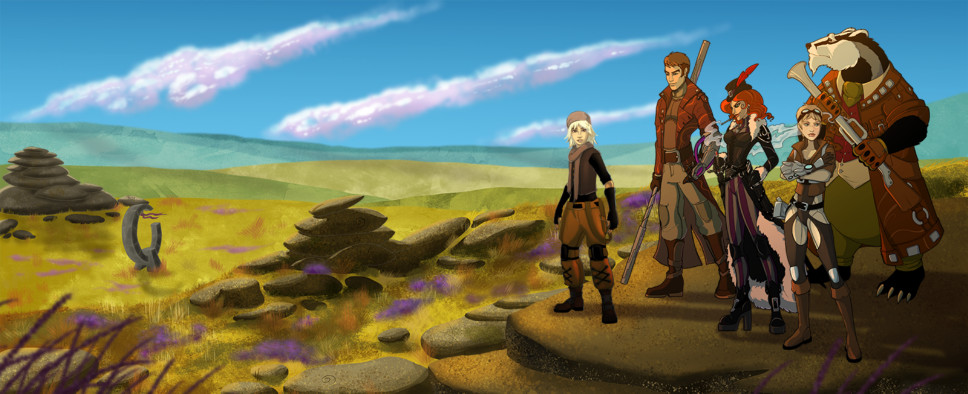Grimshade Reaches Initial Kickstarter Goal, $100,333 and Counting
-
Category: News ArchiveHits: 1522

Grimshade, Talerock's tactical story-driven RPG with JRPG influences, has reached its $100,000 Kickstarter goal with just a few days left in its campaign. So, if you like steampunk-themed fantasy worlds, anthropomorphic animals, colorful characters, and tactical battles, you now have something to look forward to.
Here's a thank you message from the developers:
Hi backers! We’ve raised the money we needed. Hooray! Hooray! Hooray! Now Grimshade has the financing it needs, and our little elves are hard at work putting together your bonuses and gifts.
There are only a few days left until the official close of the campaign, so if you want to support our game, increase your pledge, or purchase some kind of “delicious” add-on, you still can!
Thank you again! You’re the best!
And now that the game is actually on track to be released, let's check out some of the more informative campaign updates. Update #15 introduces us to a Charlie, one of the game's playable characters. Update #17 talks about Grimshade's Moo'Shoe people, while update #18 is all about the game's art style.
Here's a bit about Grimshade's art:
Back in the days when we were young and innocent (that is, eighteen months ago), we thought we'd be making a super-styled indie game with skeletal 2D character animation in Spine, for instance. Obviously, this had been a dead-end already from the start, because the heartless isometry (and we just wouldn't settle for anything less) required too many animations per each character's movement, and generally had too many requirements. In fact, we were forced to start with finding an extra-skilled animator, which we simply didn't have at the early stages of the development.
So we thought, okay, let's just make our characters 3D models, but keep the old-school painted everything else. Young and desperate, we had no idea that since the times of Baldur's Gate game developers have been starting with modeling the environment and then turning it into sprites. Well, we actually had the idea, because we carefully studied their experience, but nevertheless, we decided that we'd create the environment, paint it with our very hands because it was so much more beautiful and fascinating. And that was the thing that nobody had done before (almost).
If the environment is hand-painted, you can't use Unity procedural lighting. As well as shadows and other perks of procedural generation. And here you have to make a choice. Either you draw the entire location, but your character movement will be restricted to walking along a conditional road, and it can never step behind any obstacles, or you end up with a bunch of small sprites of shrubs and stones, each in their own layer, and light and shadows must be mapped out manually on top of the assembled location. The trick is that you must mind the resources and do your best to re-use your environmental sprites, so you simply can't afford drawing the correct light/shadow on a sprite. The same stone or pebble can be on a forest clearing or in dark shadow.
We took the other option. You see, we wanted to create big locations for you to explore, complete quests, fight monsters, and interact with NPCs. Therefore, our 3D model must be able to walk behind an object, which is, in fact, a flat sprite. Our miracle-working programmers made it possible for the 3D Badger to step behind a flat tree without falling into flat terrain! That's what we call magic. By the by, we don't have any magic as such in the world. A typical Grimshade location is a layered pie made of objects, each of which is on their own layer (like in a working file of an artist), plus parameters and polygons that allow the 3D character to interact with them (run around, step behind, or step over) as if they were three-dimensional.
The current algorithm is as follows: a level designer assembles a location draft and orders a billion sprites, which can be re-used in different parts of this location or other places in the game (for instance, a wooden box will be the same good old wooden box in any given environment). Artists create neat isometric houses, walls, bridges, staircases, ladders, boxes, and what-not of all kinds. The level designer carefully assembles all the parts into a beautiful, logical, and combat- and quest-appropriate location. It passes through numerous tests, and it's only at this stage that it is sent back to the artists for lighting. Every attempt to "move" an object after this stage will result in partial re-lighting of the location.
The light chart (which includes each source of light, every shadow) overlays the location. Here's when we add all kinds of 2D animations, such as rising smoke, birdies, water waves, and voila, it's the world where your character's model can live in.
It exists in the 3D world and doesn't care about the flat chart of lights and shadows. We went even further and made a shader, which selects the tone and color from a custom location color map and applies the hues to the model. The other, dark part of the color map is used to adjust the character's animated shadow intensity. Thus, if the character is in the shadow, its model will turn darker, its shadow will become less intense, and if it goes out into the sun, it will look brighter, more yellowish, with a darker contrasting shadow.
This is just a small part of our path. We are facing new challenges in our new isometric location: have you ever seen the sky in any such location? We’ll show you the sky! We’ll also build a Venice-like town on water, and tons of new tasks never-solved-before. We're craving to make each and every day stunning, beautiful — and convincing.

